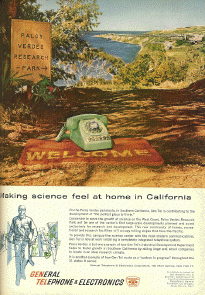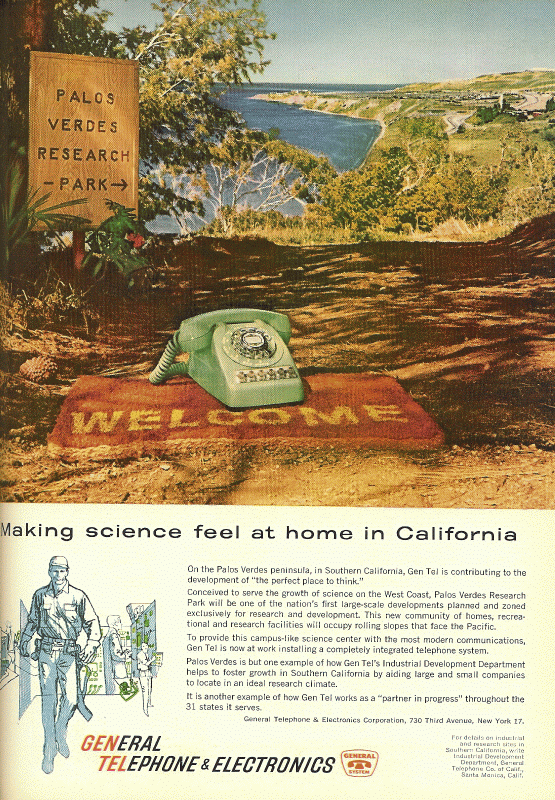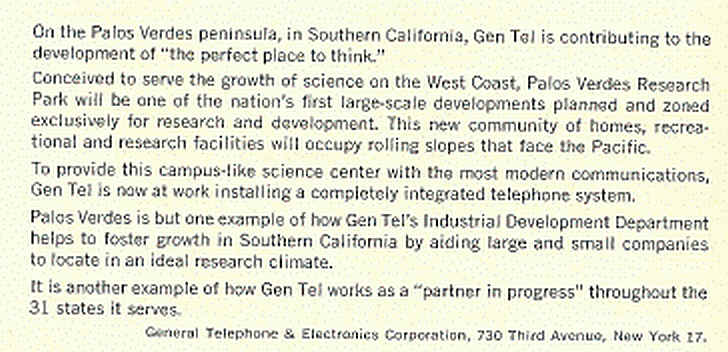|
Making science feel at home in California |
|
| Making science feel at home in California
On the Palos Verdes peninsula, in Southern California, Gen Tel is contributing to the development of "the perfect place to think." Conceived to serve the growth of science on the West Coast, Palos Verdes Research Park will be one of the nation's first large-scale developments planned and zoned exclusively for research and development. This new community of homes, recreational and research facilities will occupy rolling slopes that face the Pacific. To provide this campus-like science center with the most modern communications, Gen Tel is now at work installing a completely integrated telephone system. Palos Verdes is but one example of how Gen Tel's Industrial Development Department helps to foster growth in Southern California by aiding large and small companies to locate in an ideal research climate. It is another example of how Gen Tel works as a "partner in progress" throughout the 31 states it serves. General Telephone & Electronics Corporation, 730 Third Avenue, New York 17. GENERAL TELEPHONE & ELECTRONICS For details on industrial and research sites in Southern California write Industrial DevelopmentDepartment, General Telephone Co. of Calif., Santa Monica, Calif.
|
|
|
But.... What ever happened to this project? Aside from the Nortronics Research Facility I do not recall anything like this being completely developed in the 1960's. I wish there had been more development as Nortronics was a defense plant and dumpster raids were forbidden! The GTE installation yard was not too far away though and I spent many a fine hour rooting through the dumpster and recycle bins there! This General Telephone ad was from "Harpers Magazine" July 1961, inside back cover. If anyone has any further data on this please send to info@smecc.org - Thanks Ed Sharpe Archivist for SMECC Nick Green at the Daily Breeze contacted me when they were doing the article wanted to ask questions and use our picture here! soooooo.... here is some more info at the bottom of this page!
|
|
|
|
|
Daily Breeze article on the Palos Verdes
Research Park (page A4 of 12/31/06)NOT 'THE PERFECT PLACE'Author(s): Nick Green (C) DAILY BREEZE Date: December 31, 2006 When first proposed in 1958, Palos Verdes Research Park was touted as "the perfect place to think." Instead the proposal prompted a typical fight over development on the Palos Verdes Peninsula and five years later the nascent idea was all but dead. Few South Bay residents today remember the proposed 400-acre "campuslike science center," originally envisioned to include an observatory and think tanks. But the development near Hawthorne Boulevard and Crest Road became a hotly debated issue in what was then an unincorporated area and today is part of Rolling Hills Estates. Today virtually all that is left of it is a mention on the Web site of the Southwest Museum of Engineering, Communications and Computation in Glendale, Ariz., at smecc.org. Archivist Ed Sharpe, a 1970 Rolling Hills High School graduate, grew up nearby and remembers the controversy. "I would have loved having that entire campus area for a lab area for myself and a place to live," he said. "It could have been pulled off elegantly, but I can see why people would have been afraid." The park's deep-pocketed proponents included General Telephone and Great Lakes Property Inc., which owned thousands of acres of land on The Hill. They spent more than $250,000 on full-page color ads in such glossy periodicals as National Geographic and Harper's Magazine to tout its merits. "Conceived to serve the growth of science on the West Coast, Palos Verdes Research Park will be one of the nation's first large-scale developments planned and zoned exclusively for research and development," the ads said. "This new community of homes, recreational and research facilities will occupy rolling slopes that face the Pacific." In May 1960 the park's backers held a groundbreaking ceremony using a hand-held plow towed by a helicopter in an apparent nod to the pending modernization of the rural Peninsula. The first tenant: the Nortronics division of Northrop Corp., which planned a $4 million scientific research center on 100 acres of land. "This is a significant milestone in the program to provide our scientists and creative staff with the ideal environment for research," Northrop executive Frederick Stevens said. "When completed, facilities will represent an unexcelled combination of location, setting, climate, scenery, seclusion and campuslike atmosphere, all designed to stimulate (the) creative talents of our research and development teams." But the proposal soon became mired in controversy when the park's owners sought to relax zoning restrictions to allow for limited development of prototypes -- in other words, light manufacturing. Against a backdrop that has been repeated many times over the last 45 years, critics that included the Rolling Hills City Council fretted over what they perceived as inappropriate development on the semirural and largely residential Peninsula. The argument: allowing even limited manufacturing would "degrade the residential worth of the land." "We have a right to worry," Councilman V.G. Nielsen was quoted as saying in a December 1961 Daily Breeze article. "We don't want industry around the Peninsula and we don't want it to gain a foothold." Opponents prevailed and by 1962 park backers capitulated and shifted their focus to building homes on as many as 270 acres of the site. But critics assailed that idea as well -- in part because of the expected influx of students to the Palos Verdes Peninsula Unified School District -- and throughout 1962 battle lines formed over what the Breeze had taken to calling "the battle of research park." County officials eventually approved a limited residential development, but most of the site was not rezoned. Around the same time Rolling Hills Estates moved to annex 875 acres of land, including the park site and including Marineland in what is today Rancho Palos Verdes. That acreage was later reduced to 375 acres and voters overwhelmingly approved the annexation in March 1963. By midsummer, with Great Lakes fighting the annexation in court and no other companies having followed Northrop's lead to locate operations at the park, the company announced it would sell 107 acres of land as a site for what was then being called South Bay State College. Great Lakes' lawyer contended the research park would never be developed because companies found the zoning too restrictive. But opponents, including the three local cities as well as the school district, rallied once more, fearing that what amounted to an elimination of the park would remove valuable land from the tax rolls. In the end, the push for the college campus was abandoned in favor of the current Carson location of California State University, Dominguez Hills. Gradually, though, the land was parceled off and sold for residential development. Northrop remained into the 1990s, but in 1991 the company announced it was in negotiations to sell the 34 acres it still occupied. The reason, according to a March 1991 Breeze article: skyrocketing home values had made it difficult to recruit scientists. By 2003, the 68-home Vantage Point subdivision -- the last of the city's large subdivisions -- had risen in its place and the last remnant of the research park had vanished. ______________________________________________________ **** THIS IS WHERE OUR GTE AD WENT!***
Caption: Copyright (c) 2006, Daily Breeze, All Rights Reserved
|
|
| For interest - a few other GTE ad designs of that era. - We are looking for larger copies. | |
1960 General Telephone
|
|
1961 General Telephone |
|
1962 General Telephone 1964 General Telephone 1965 General Telephone The City of Rolling Hills Estates officially became Los Angeles County's 60th municipality on September 18, 1957. In that first year, the City's population totaled only 3,500; but its new citizens were united in their concern over maintaining the community's rural atmosphere characterized by rolling hills, vast open spaces and white fences.Annexation of new areas to the
City was another ongoing concern during the City's early years. In 1959,
the Montecillo, Chandler Quarry, Country Club Estates and northern
Masongate areas were added to the eastern and western portions of the
City. Later annexations from 1960-66 included the research and development
land behind the Northrop Corporation; the Peninsula Center, Harbor Sight,
the Ranch, Rolling Hills Park Estates, Highridge, Hillcrest Manor,
Hillcrest Meadows, Terraces, and Cresta Verdes areas. In 1982, the site of
the former Palos Verdes Landfill was annexed to assure that City concerns
regarding this closed facility would be recognized.
This General Telephone ad was from
"Harpers Magazine" July 1961, inside back cover. Ad
courtesy of Ed Sharpe Director/Archivist for SMECC and RHHS (now
Peninsula High) Class of '70 (Del Cerro) - www.smecc.org
|
|




